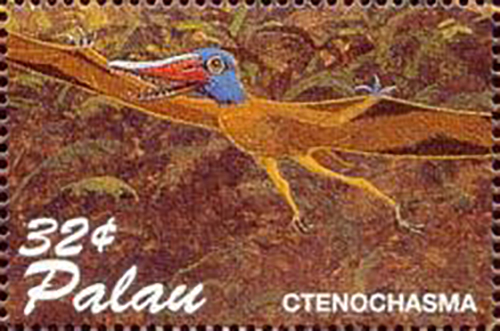Ctenochasma roemeri Meyer, 1852

Foto: Ghedoghedo
(Da: en.wikipedia.org)
Phylum: Chordata Haeckel, 1874
Subphylum: Vertebrata Cuvier, 1812
Classe: Reptilia Laurenti, 1768
Ordine: Pterosauria Kaup, 1834
Famiglia: Ctenochasmatidae Nopsca, 1928
Genere: Ctenochasma Meyer, 1852
Descrizione
La caratteristica principale di questo pterosauro risiedeva nel cranio: era dotato di lunghe mascelle armate di denti lunghi e sottilissimi (in tutto 260), che andavano a formare una sorta di “pettine” grazie al quale, probabilmente, il Ctenocasma filtrava il cibo dall'acqua. Le dimensioni di questo animale erano piuttosto piccole (circa 45 centimetri di apertura alare negli esemplari più grandi); la specie più piccola, Ctenochasma elegans, non superava i 25 centimetri di apertura alare. Per il resto l'aspetto non si discostava di molto da quello dello pterodattilo (gen. Pterodactylus): la coda era corta, le ali erano molto ampie e consentivano un volo preciso. Si conoscono tre specie di ctenocasma: oltre a C. elegans (precedentemente ritenuto una specie di Pterodactylus), C. porocristata e C. roemeri. Fossili molto belli di ctenocasma sono stati rinvenuti nei calcari litografici di Solnhofen, in Baviera, che hanno restituito anche gli esemplari del primo uccello, Archaeopteryx. Parente stretto dello Ctenochasma è anche lo Gnathosaurus
Diffusione
Pterosauro vissuto nel Giurassico superiore in Europa.
Bibliografia
–von Meyer, C.E.H. (1852). "Ctenochasma Roemeri." Paläontographica, 2: 82-84 & pl. 13.
–Oppel A. (1862). "Über Fährten im lithographischen Schiefer. Paläontologische Mitteilungen aus dem Museum des Koenigl." Bayrischen Staates, ed. A. Oppel, vol. 1, pp. 121-125 & pl. 39. Stuttgart: Ebner & Sembek.
–Bennett, S. Christopher (2013). "New information on body size and cranial display structures of Pterodactylus antiquus, with a revision of the genus". Paläontologische Zeitschrift. 87 (2): 269-289.
–Bennett, S.C. (1996). "Year-classes of pterosaurs from the Solnhofen Limestone of Germany: Taxonomic and Systematic Implications". Journal of Vertebrate Paleontology. 16 (3): 432-444.
–Taquet, P. (1972). "Un crane de Ctenochasma (Pterodactyloidea) du Portlandien infe rieur de la Haute-Marne, dans les collections du Musee de St-Dizier". Comptes Rendus de l'Académie des Sciences. 174: 362-364.
–Jouve, S. (2004). "Description of the skull of a Ctenochasma (Pterosauria) from the latest Jurassic of eastern France, with a taxonomic revision of European Tithonian Pterodactyloidea". Journal of Vertebrate Paleontology. 24 (3): 542-554.
–Bennett, S.C. (2007). "A review of the pterosaur Ctenochasma: taxonomy and ontogeny". Neues Jahrbuch für Geologie und Paläontologie - Abhandlungen. 245 (1): 23-31.
–Wilton, Mark P. (2013). Pterosaurs: Natural History, Evolution, Anatomy. Princeton University Press.
–Bennett, S.C. (2018). "New smallest specimen of the pterosaur Pteranodon and ontogenetic niches in pterosaurs". Journal of Paleontology. 92 (2): 254-271.
–Schmitz, L.; Motani, R. (2011). "Nocturnality in Dinosaurs Inferred from Scleral Ring and Orbit Morphology". Science. 332 (6030): 705-8.
–Andres, B.; Clark, J.; Xu, X. (2014). "The Earliest Pterodactyloid and the Origin of the Group". Current Biology. 24 (9): 1011-6.

|
Data: 22/04/1995
Emissione: Dinosauri Stato: Palau Nota: Emesso in un minifoglio di 18 v. diversi |
|---|